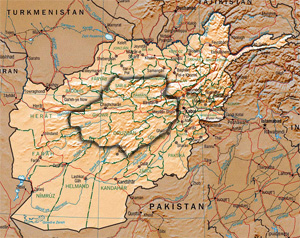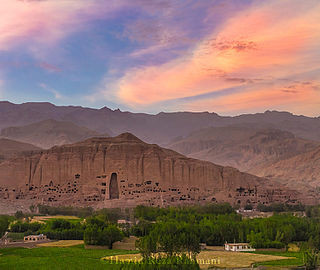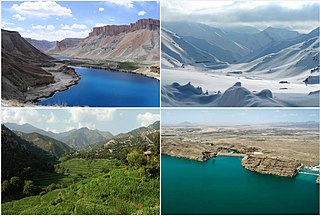
Hazāristān or Hazārajāt is a mountainous region in the central highlands of Afghanistan, among the Koh-i-Baba mountains in the western extremities of the Hindu Kush. It is the homeland of the Hazara people who make up the majority of its population. "Hazārajāt denotes an ethnic and religious zone." Hazarajat is primarily made up of the provinces of Bamyan, Daykundi, Ghor and parts of northern Ghazni, Urozgan, Parwan and Maidan Wardak. The most populous towns in Hazarajat are Bamyan, Yakawlang (Bamyan), Nili (Daykundi), Lal wa Sarjangal (Ghor), Sang-e-Masha (Ghazni), Gizab (Urozgan) and Behsud. The Kabul, Farah, Hari, Murghab, Balkh and Kunduz rivers originate from Hazarajat.

Bamyan Province is one of the thirty-four provinces of Afghanistan, located in the central highlands of the country. Its terrain is mountainous or semi-mountainous, at the western end of the Hindu Kush mountains concurrent with the Himalayas. The province is divided into eight districts, with the town of Bamyan serving as its capital. The province has a population of about 455,000 and borders Samangan to the north, Baghlan, Parwan and Wardak to the east, Ghazni and Daykundi to the south, and Ghor and Sar-e Pol to the west. It is the largest province in the Hazarajat region of Afghanistan, and is the cultural capital of the Hazara ethnic group that predominates in the area.

Bamyan also spelled Bamiyan or Bamian is the capital of Bamyan Province in central Afghanistan. With an altitude of about 2,550 m and a population of about 100,000, Bamyan is the largest town in the central Afghanistan region of Hazarajat, and lies approximately 240 kilometres north-west of Kabul, the national capital. It also refers to the surrounding valley. Many statues of Buddha are carved into the sides of cliffs facing Bamyan city. In 2008, Bamyan was found to be the home of the world's oldest oil paintings. The city of Bamyan has four districts and a total land area of 3,539 hectares. The total number of dwellings in this city are 4,435.

Kahmard is a district of Bamyan Province in central Afghanistan. It is located at an altitude of 1,475 meters, with a population of 31,042. Kahmard is situated 140 km from Bamiyan city, in the north of the province, and is divided into five valleys.

Saighan District is part of Bamyan Province, Afghanistan. As of 2003 it has a population of 23,215. It was created in 2005 from part of Kahmard District, and until 2004 was part of Baghlan Province. Saighan town is the largest town and the administrative center. The district has an area of 1,741 km2 and contains sixty-two villages. Neighboring districts are Bamyan District to the south, Yakawlang District to the west, Kahmard District to the north, and Shibar District to the east.

Shahristan is a district in Daykundi Province, Afghanistan. Daykundi var established as a province in the distant north area in Uruzgan province in 2004,

Panjab district is in the central part of Bamiyan Province, Afghanistan. The capital is the town of Panjab. Panjab contains 5 valleys, the water running through the 5 valleys meet in the centre of the district. Its population is entirely Hazara people.

Shibar District is located in the western end of the Bamyan Province in Afghanistan. It is in a mountainous region. The main village Shibar is at 2,637 m altitude on the all-seasons secondary road from Bamyan to Kabul through the Shibar pass.

Yakawlang District is located in the northwestern part of Bamyan Province. Its population is 76,897 (2011) predominantly from the Hazara ethnic group. The capital city Yakawlang formerly held 60,000 residents, and it was completely destroyed by Taliban forces in 2001. Massacres of civilians by the Taliban were reported by Human Rights groups.
There is a gravel surfaced airport near the city.

Bamyan is a district of Bamyan Province in Afghanistan. In 2003, the population was put at 70,028, of which the majority group is Hazara while the Tajik is a minority group. New Zealand peace keepers operate in the district as well as most of Bamyan Province.

Abtu, Afghanistan is a village in Bamyan Province in northern-central Afghanistan.

Barik-e Sofla is a village in Bamyan Province in northern-central Afghanistan.

Fatmasti is a village in Bamyan Province in central Afghanistan.

Gonbad, Afghanistan is a village in Bamyan Province in central Afghanistan.

Heydarabad, Afghanistan is a village in Bamyan Province in central Afghanistan.

The tourism industry of Afghanistan, developed with government help in the early 1970s, is gradually reviving after the decades of war. A valid passport with visa is required for entrance into Afghanistan. In 1999, the United Nations estimated the daily cost of staying in Kabul at $70 USD.

Anwar Rahmati is an ethnic Hazara politician in Afghanistan. He is the current governor of Daykundi province he appointed as the new governor of Daykundi inplace of Mahmoud Baligh on November 22, 2018. Previously he served as Governor of Sar-e Pol from May 25, 2010 to April 3, 2012 and as Governor of Ghor from August 27, 2012 to June 27, 2015. Between 2004 and 2010 he was Chief of staff to Karim Khalili.

Band-e-Amir Dragons or Band-e-Amir Region is one of six regional first-class cricket teams in Afghanistan. In the 2017 Shpageeza team auction, the Band-e-Amir Dragons team was bought by Paragon Business Group, a Finance and investment company, and it will play as the Paragon Band-e-Amir Dragons in this competition. The Region represents the following provinces in the centre of Afghanistan: Ghazni, Bamyan, Parwan, Panjshir, Daykundi, and Wardak. The team is named after Band-e Amir, a series of six deep blue lakes in Bamyan Province.







